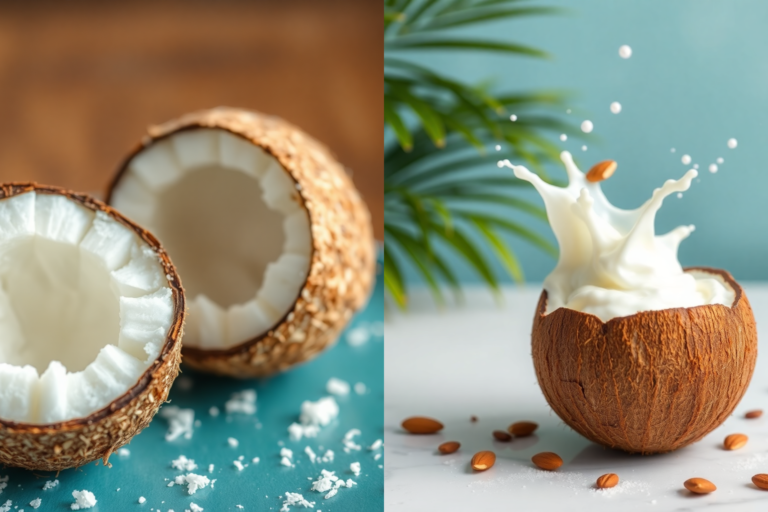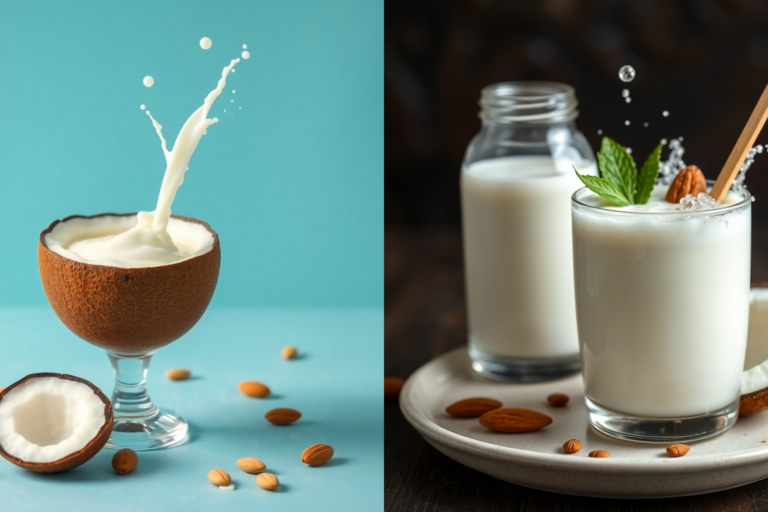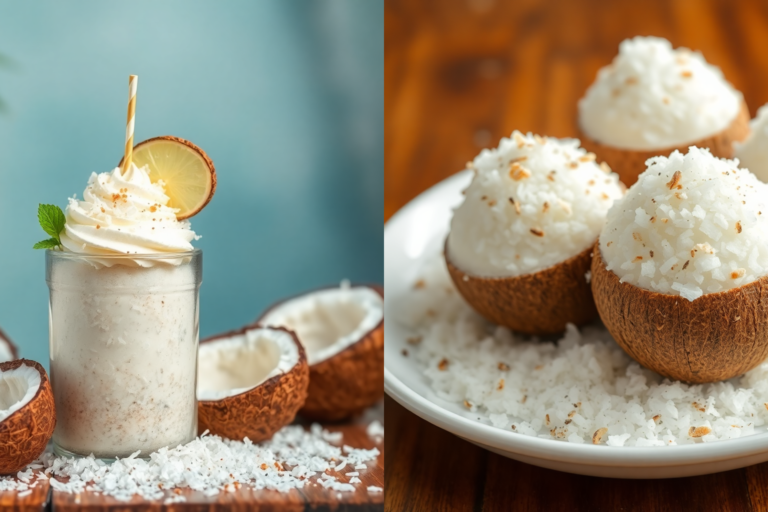Introduction of Coconut Milk vs Almond Milk
In recent years, plant-based milks have surged in popularity as more people seek alternatives to dairy for various reasons, including health, dietary restrictions, and environmental concerns. Among the myriad options available, coconut milk and almond milk stand out as two of the most popular choices. These plant-based milks are celebrated not only for their nutritional benefits but also for their unique taste and texture profiles.
This article aims to delve deeply into a comparison of coconut milk vs almond milk, focusing on how they differ in terms of flavor and mouthfeel. By exploring the specific characteristics that define each milk, we can better understand their roles in different culinary applications and how they cater to diverse consumer preferences.
To provide a comprehensive understanding of coconut milk vs almond milk, we will present 9 expert insights. These insights will cover various aspects, including the distinct flavor profiles, texture and consistency, culinary applications, complementary pairings, versatility in recipes, consumer preferences, nutritional impact on taste, adaptation in beverages, and potential modifications at home. Through this detailed comparison, we hope to offer valuable information that will help you make an informed choice between coconut milk and almond milk based on your personal preferences and culinary needs.
Expert Insight 1: Flavor Profile Coconut Milk vs Almond Milk
Detailed Comparison of the Distinct Flavors of Coconut Milk vs Almond Milk
When comparing the flavor profiles of coconut milk vs almond milk, it’s clear that each brings a unique set of taste characteristics to the table. Coconut milk is known for its rich, creamy flavor with a pronounced coconut taste. This natural sweetness and tropical essence make it a distinctive addition to many dishes. The flavor can vary slightly depending on whether the coconut milk is in canned form, which is typically thicker and richer, or in a carton, which is usually lighter and more diluted.
In contrast, almond milk offers a milder, subtler flavor. The nuttiness of almond milk is gentle, with a hint of natural sweetness that doesn’t overpower. This makes almond milk a versatile option that blends well with a variety of other flavors without dominating them. Unlike the strong coconut notes in coconut milk, almond milk provides a more neutral base, which can be advantageous in recipes where a less intense flavor is desired.
Discussion of Natural Sweetness, Nuttiness, and Any Underlying Taste Notes in Coconut Milk vs Almond Milk
Coconut milk’s natural sweetness is one of its defining characteristics. The inherent sugars in coconut give it a pleasant, sweet undertone that can enhance desserts and beverages. Additionally, the nutty flavor of coconut milk, combined with its creamy texture, makes it a favored ingredient in savory dishes like curries and soups, where it adds depth and richness.
Almond milk, while also slightly sweet, is known more for its nutty flavor. This nuttiness is subtle and doesn’t overwhelm, making almond milk a preferred choice for people looking for a dairy alternative that doesn’t impart a strong flavor to their recipes. The sweetness in almond milk is often described as delicate, allowing it to complement both sweet and savory dishes without altering the intended taste profile significantly.
Underlying taste notes in coconut milk include a slight tanginess, especially in canned versions, which can add complexity to recipes. Almond milk, on the other hand, often carries a faint hint of roasted almonds, depending on the brand and processing method, contributing to its overall mild and pleasant flavor.
In the coconut milk vs almond milk debate, flavor profile plays a significant role in determining which milk to use for different culinary applications. Coconut milk’s bold, sweet, and creamy characteristics make it ideal for rich, flavorful dishes, while almond milk’s mild, nutty, and neutral profile allows it to blend seamlessly into a wide variety of recipes. Understanding these distinct flavor profiles helps in choosing the right milk for your culinary creations.
Expert Insight 2: Texture and Consistency
Examination of the Texture and Mouthfeel of Both Coconut Milk vs Almond Milk
When examining the texture and mouthfeel of coconut milk vs almond milk, distinct differences emerge. Coconut milk is generally thicker and creamier, especially when it comes in its canned form. The high-fat content in coconut milk gives it a luxurious, velvety texture that coats the palate, making it a popular choice for adding richness to recipes.
Almond milk, in contrast, has a lighter and more watery consistency. Its lower fat content contributes to a smoother, less dense mouthfeel. This lighter texture makes almond milk a refreshing alternative in beverages and cereals, providing a clean and crisp drinking experience.
Differences in Thickness and Creaminess Between Coconut Milk vs Almond Milk
The thickness of coconut milk vs almond milk is a key differentiator. Coconut milk, particularly the canned variety, has a substantial body that can be almost spoonable when chilled. This thickness is due to the higher concentration of coconut cream, which contains more fats and oils. Carton coconut milk, while still thicker than many plant-based milks, is somewhat diluted to make it more drinkable.
Almond milk, on the other hand, is uniformly thinner regardless of whether it comes from a carton or is homemade. The production process typically involves blending almonds with water and then straining out the solids, resulting in a milk that is smooth but not as dense. This consistency makes almond milk a versatile addition to smoothies, where its lighter texture blends easily without overwhelming other ingredients.
In the coconut milk vs almond milk comparison, the creaminess factor is another crucial aspect. Coconut milk’s creaminess makes it an excellent choice for recipes that benefit from a rich, silky texture, such as soups, curries, and desserts. Almond milk, with its more delicate creaminess, works well in recipes that require a lighter touch, like baked goods and certain beverages.
Understanding the differences in texture and consistency between coconut milk vs almond milk can help in selecting the right milk for various culinary applications. Coconut milk’s thick, creamy texture enhances dishes that need a luxurious mouthfeel, while almond milk’s light, smooth consistency is ideal for those looking for a refreshing and subtle addition.
Expert Insight 3: Culinary Applications
Analysis of How the Taste and Texture of Coconut Milk vs Almond Milk Affects Their Use in Cooking and Baking
When considering the culinary applications of coconut milk vs almond milk, their distinct taste and texture play pivotal roles in determining which milk to use in various recipes. The rich, creamy texture and pronounced coconut flavor of coconut milk make it an excellent choice for dishes that benefit from added depth and richness. In contrast, the mild, nutty flavor and lighter consistency of almond milk make it versatile for a wide range of culinary uses without overpowering other ingredients.
Examples of Dishes Where Coconut Milk vs Almond Milk Excels
Smoothies
In smoothies, both coconut milk and almond milk shine, but they contribute differently to the final product. Coconut milk adds a creamy, tropical twist to smoothies, making it perfect for blends with fruits like pineapple, mango, and banana. Its thickness enhances the smoothie’s richness, creating a satisfying texture.
Almond milk, with its lighter consistency, is ideal for those who prefer a smoother, more fluid smoothie. It pairs well with berries, spinach, and protein powders, allowing these ingredients’ flavors to stand out while providing a subtle nutty undertone.
Curries
Coconut milk is a staple in many curry recipes, particularly in Thai and Indian cuisines. Its creamy texture and rich flavor complement the bold spices used in curries, creating a harmonious and luxurious sauce. Dishes like Thai green curry, Indian chicken curry, and Malaysian laksa rely on coconut milk to achieve their characteristic richness and depth of flavor.
Almond milk, while less traditional in curry recipes, can be used as a lighter alternative for those seeking a lower-fat option. It’s best used in mild, less spicy curries where its subtle flavor won’t be overshadowed by strong spices. Almond milk can provide a creamy texture without the heaviness of coconut milk, making it suitable for lighter, vegetable-based curries.
Desserts
Coconut milk is a favorite in dessert recipes, especially those that require a rich, creamy base. Its natural sweetness and tropical flavor make it perfect for coconut-based desserts like coconut ice cream, flan, and rice pudding. Coconut milk is also a key ingredient in many vegan and dairy-free desserts, providing the creaminess that dairy usually imparts.
Almond milk is widely used in baking and dessert recipes as a dairy substitute. Its mild flavor and smooth texture make it an excellent choice for cakes, muffins, and cookies. Almond milk can also be used in puddings and custards, where it provides a creamy texture without the strong flavor of coconut milk. It’s particularly popular in recipes that call for a neutral-flavored liquid to allow other ingredients to shine.
Conclusion
In the culinary applications of coconut milk vs almond milk, understanding their unique taste and texture characteristics is essential for choosing the right milk for your recipes. Coconut milk excels in adding richness and depth to smoothies, curries, and creamy desserts, while almond milk offers a lighter, more versatile option for smoothies, baked goods, and a variety of other dishes. By leveraging the strengths of each milk, you can enhance the flavors and textures of your culinary creations.
Expert Insight 4: Complementary Pairings
Suggestions on Which Flavors and Ingredients Pair Well with Coconut Milk and Almond Milk
Pairing the right flavors and ingredients with coconut milk vs almond milk can elevate your culinary creations to new heights. Understanding how these milks interact with different flavors can help you create balanced and delicious dishes.
Coconut Milk Pairings
Tropical Fruits
Coconut milk’s natural sweetness and tropical flavor pair beautifully with fruits like mango, pineapple, and passion fruit. Use coconut milk as a base for smoothies, fruit salads, or as a topping for desserts featuring tropical fruits.
Spices
Coconut milk enhances the flavors of spices like curry powder, turmeric, ginger, and lemongrass. Use it in curries, soups, and stews to create rich, aromatic dishes with layers of flavor.
Chocolate
The creamy texture of coconut milk complements the richness of chocolate perfectly. Use coconut milk in chocolate desserts like puddings, mousses, and cakes for a luxurious and indulgent treat.
Tips for Enhancing Recipes Using Coconut Milk Pairings:
- Balance Flavors: Use coconut milk to balance spicy, sour, or acidic flavors in dishes.
- Creaminess: Use coconut milk to add creaminess to both sweet and savory dishes without dairy.
- Layered Flavors: Experiment with layering flavors by adding coconut milk at different stages of cooking for depth and complexity.
Almond Milk Pairings
Berries
The subtle nuttiness of almond milk pairs well with the tartness of berries like strawberries, raspberries, and blueberries. Use almond milk in smoothies, oatmeal, or cereal bowls topped with fresh berries.
Vanilla
Almond milk’s neutral flavor makes it a perfect match for vanilla. Use it in recipes where you want the vanilla flavor to shine, such as vanilla cakes, pancakes, or creamy desserts like panna cotta.
Coffee
Almond milk’s light texture and slightly nutty flavor complement the bitterness of coffee. Use it as a dairy alternative in lattes, cappuccinos, and cold brews for a creamy and satisfying coffee experience.
Tips for Enhancing Recipes Using Almond Milk Pairings:
- Nutty Flavors: Use almond milk to enhance the nutty flavor in dishes like granola, nut butter smoothies, and almond-based desserts.
- Subtle Sweetness: Almond milk adds a gentle sweetness to recipes without overpowering other flavors, making it ideal for both sweet and savory dishes.
- Versatility: Almond milk can be used in a wide range of recipes due to its neutral flavor, making it a versatile ingredient in both cooking and baking.
By pairing coconut milk and almond milk with complementary flavors and ingredients, you can create delicious and well-balanced dishes that highlight the unique characteristics of each milk. Experiment with different combinations to discover new flavor profiles and enhance your culinary repertoire.
Expert Insight 5: Versatility in Recipes
Discussion of the Versatility of Coconut Milk vs Almond Milk in Different Cuisines
Coconut milk vs almond milk offer remarkable versatility in various cuisines, each bringing its own unique flavor and texture to dishes from around the world.
Coconut Milk’s Versatility
Southeast Asian Cuisine
Coconut milk is a staple in Southeast Asian cuisine, where it is used in savory dishes like Thai curries, Indonesian rendang, and Filipino adobo. Its rich, creamy texture and tropical flavor complement the bold spices and ingredients common in these cuisines.
Caribbean Cuisine
In Caribbean cuisine, coconut milk is used in dishes like Jamaican rice and peas, Trinidadian callaloo, and Bahamian conch chowder. Its sweetness balances the heat of peppers and spices, while its creaminess adds depth and richness to stews and soups.
Almond Milk’s Versatility
Western Cuisine
Almond milk has become a popular dairy alternative in Western cuisine, where it is used in a variety of dishes ranging from breakfast to desserts. It works well in creamy pasta sauces, mashed potatoes, and baked goods like muffins, pancakes, and cakes.
Middle Eastern Cuisine
In Middle Eastern cuisine, almond milk is used in desserts like baklava and rice pudding, adding a subtle nutty flavor and creamy texture. It’s also used in savory dishes such as almond-based sauces for meats and almond milk-based soups.
Insights on Using Each Milk in Savory Versus Sweet Dishes
Coconut Milk
- Savory Dishes: Coconut milk shines in savory dishes like curries, soups, stews, and marinades. Its creamy texture and tropical flavor enhance the richness of these dishes, while its sweetness balances spicy and savory flavors.
- Sweet Dishes: Coconut milk is also a star ingredient in sweet dishes like desserts, ice creams, puddings, and smoothies. Its natural sweetness and creamy texture make it perfect for creating indulgent treats.
Almond Milk
- Savory Dishes: Almond milk works well in savory dishes like creamy sauces, soups, and risottos, providing a subtle nutty flavor without overpowering other ingredients. It’s also suitable for dairy-free mashed potatoes and savory bakes.
- Sweet Dishes: In sweet dishes, almond milk adds a delicate sweetness and nutty undertone. It’s commonly used in baked goods like cakes, cookies, and pies, as well as in puddings, custards, and breakfast bowls.
Conclusion
Coconut milk vs almond milk offer immense versatility in both savory and sweet dishes across various cuisines. Understanding their unique characteristics allows you to leverage their flavors and textures to enhance your culinary creations, whether you’re cooking up a fragrant Thai curry or baking a batch of vegan almond milk cookies. Experimenting with these plant-based milks opens up a world of possibilities in the kitchen.
Expert Insight 6: Consumer Preferences
Overview of Consumer Preferences Based on Taste and Texture of Coconut Milk vs Almond Milk
Understanding consumer preferences regarding the taste and texture of coconut milk vs almond milk provides valuable insights into their usage in various culinary contexts.
Survey or Study Findings on Which Milk is Favored for Certain Uses
Taste Preferences
- Coconut Milk: According to surveys, consumers who prefer coconut milk often cite its rich, creamy texture and tropical flavor as appealing factors. Many enjoy coconut milk in curries, desserts, and tropical-inspired dishes.
- Almond Milk: Almond milk is favored by consumers for its light, nutty flavor and versatility. Survey results indicate that almond milk is popular for everyday use, such as in coffee, cereal, and smoothies.
Texture Preferences
- Coconut Milk: Consumers who prioritize creaminess and richness tend to favor coconut milk, especially in dishes where a thick, indulgent texture is desired, like curries and creamy soups.
- Almond Milk: Those who prefer a lighter texture often choose almond milk, which is perceived as less heavy than coconut milk. Almond milk is commonly used in beverages, baking, and lighter sauces.
Specific Uses
- Cooking and Baking: While both coconut milk and almond milk are used in cooking and baking, coconut milk is often preferred in rich, savory dishes like curries and stews, while almond milk is favored for baking, where its neutral flavor complements a wide range of recipes.
- Beverages: Almond milk is frequently chosen as a dairy alternative in coffee, tea, and smoothies due to its light texture and subtle flavor. Coconut milk is preferred in tropical-flavored beverages and creamy cocktails.
Conclusion
Consumer preferences for coconut milk vs almond milk vary based on taste, texture, and specific culinary uses. While some prefer the rich, tropical flavor of coconut milk, others opt for the lighter, nuttier taste of almond milk. Understanding these preferences can help individuals and businesses cater to consumer demands and create products that align with their tastes and dietary preferences.
Expert Insight 7: Nutritional Impact on Taste
Exploration of How the Nutritional Content of Each Milk Influences Its Taste and Texture
The nutritional content of coconut milk vs almond milk plays a significant role in shaping their taste, texture, and overall culinary performance.
Impact of Fat Content, Proteins, and Other Nutrients
Coconut Milk
- Fat Content: Coconut milk is higher in fat, particularly saturated fats, which contribute to its rich and creamy texture. The fat content gives coconut milk its luxurious mouthfeel and enhances its ability to coat the palate.
- Proteins: Coconut milk contains minimal protein compared to almond milk. While this doesn’t impact its taste significantly, it affects its nutritional profile and texture, making coconut milk less likely to curdle when heated.
- Other Nutrients: Coconut milk is rich in medium-chain triglycerides (MCTs), which provide a source of energy. It also contains vitamins and minerals like manganese, copper, and iron, which can subtly influence its taste and nutritional value.
Almond Milk
- Fat Content: Almond milk is lower in fat compared to coconut milk, especially saturated fats. This results in a lighter texture and mouthfeel, making almond milk suitable for those looking for a lower-fat alternative.
- Proteins: Almond milk typically contains more protein than coconut milk, although still lower than dairy milk. The protein content contributes to the milk’s texture and can affect its ability to froth and thicken when heated.
- Other Nutrients: Almond milk is often fortified with vitamins and minerals, such as calcium, vitamin D, and vitamin E, to enhance its nutritional value. These fortifications can subtly influence the taste and texture of almond milk.
Conclusion
The nutritional composition of coconut milk vs almond milk significantly influences their taste, texture, and culinary applications. Coconut milk’s higher fat content contributes to its rich, creamy texture and tropical flavor, while almond milk’s lower fat content results in a lighter mouthfeel with a subtle nutty taste. Understanding these nutritional differences can help individuals make informed choices based on their dietary preferences and culinary needs.
Expert Insight 8: Adaptation in Beverages
Comparison of How Each Milk Performs in Beverages like Coffee, Tea, and Smoothies
When it comes to beverages like coffee, tea, and smoothies, the choice between coconut milk vs almond milk can greatly impact the taste, texture, and overall experience.
Insights on Frothing Ability and Blending
Coconut Milk
- Coffee: Coconut milk adds a creamy, tropical flavor to coffee but may not froth as well as almond milk due to its higher fat content. However, barista-style coconut milk blends designed for coffee can froth better.
- Tea: Coconut milk pairs well with chai tea and other spiced teas, adding richness and sweetness. It blends smoothly with tea but may separate if not well mixed.
- Smoothies: Coconut milk provides a rich and creamy base for smoothies, especially those with tropical fruits like mango or pineapple. Its thickness enhances the smoothie’s texture but may require additional blending to ensure a smooth consistency.
Almond Milk
- Coffee: Almond milk froths well and blends smoothly with coffee, making it a popular choice for lattes and cappuccinos. It adds a subtle nutty flavor without overpowering the coffee.
- Tea: Almond milk’s light, slightly nutty flavor complements herbal and black teas. It blends easily with tea and adds a creamy texture without altering the tea’s flavor significantly.
- Smoothies: Almond milk creates a smooth and creamy texture in smoothies without adding a strong flavor. It blends well with a variety of fruits and vegetables, making it a versatile option for smoothie recipes.
If you’re interested in exploring more coconut milk recipes, you’re welcome to visit:
https://www.thespruceeats.com/recipes-for-coconut-milk-3891321
Conclusion
In beverages like coffee, tea, and smoothies, coconut milk vs almond milk offers distinct advantages based on their taste, texture, and frothing ability. Coconut milk adds a creamy, tropical twist to beverages but may not froth as well, while almond milk provides a lighter, nuttier flavor with excellent frothing ability. Understanding these differences allows you to choose the milk that best suits your beverage preferences and creates the desired taste and texture.
Expert Insight 9: Potential Modifications
Tips on Modifying the Taste and Texture of Coconut Milk and Almond Milk at Home
Modifying the taste and texture of coconut milk vs almond milk at home allows for customization to suit individual preferences and specific recipe requirements.
DIY Methods to Adjust Sweetness, Thickness, and Flavor Intensity
Coconut Milk
- Adjusting Sweetness: To increase sweetness, add a small amount of sweetener like sugar, honey, or maple syrup to coconut milk and mix well. For a natural option, blend in ripe fruits like bananas or dates.
- Adjusting Thickness: To thicken coconut milk, simmer it gently on the stove to reduce the water content. Alternatively, mix in a small amount of cornstarch or arrowroot powder as a thickening agent.
- Intensifying Flavor: Enhance the flavor of coconut milk by toasting coconut flakes lightly and blending them with the milk. You can also add a pinch of salt to enhance the overall flavor profile.
Almond Milk
- Adjusting Sweetness: To sweeten almond milk, stir in a bit of sweetener such as agave syrup, date syrup, or vanilla extract. Adjust the amount to taste, starting with a small quantity.
- Adjusting Thickness: To thicken almond milk, blend in soaked and drained raw almonds or cashews. Strain the mixture through a nut milk bag or fine sieve for a creamier texture.
- Intensifying Flavor: Toasting almonds lightly before blending can enhance the nutty flavor of almond milk. You can also infuse almond milk with flavors like cinnamon, vanilla, or cocoa powder for added depth.
Conclusion
With simple DIY methods, you can easily modify the taste and texture of coconut milk and almond milk at home to better suit your preferences and recipe needs. Whether you prefer your milk sweeter, thicker, or with a more intense flavor, these adjustments allow for versatility in your culinary creations. Experiment with different modifications to discover your perfect homemade plant-based milk.
Conclusion
In this comprehensive exploration of coconut milk vs almond milk, we’ve delved into nine expert insights covering taste, texture, culinary applications, consumer preferences, nutritional impact, adaptation in beverages, and potential modifications. Let’s recap these insights and conclude with some final thoughts.
Flavor Profile: Coconut milk boasts a rich, tropical flavor, while almond milk offers a subtle, nutty taste.
Texture and Consistency: Coconut milk is thick and creamy, whereas almond milk is lighter and more fluid.
Culinary Applications: Both milks excel in various dishes, with coconut milk favored in rich, flavorful recipes, and almond milk in lighter, versatile ones.
Complementary Pairings: Coconut milk pairs well with tropical fruits and spices, while almond milk complements berries and vanilla.
Versatility in Recipes: Coconut milk shines in Southeast Asian and Caribbean cuisines, while almond milk is popular in Western and Middle Eastern dishes.
Consumer Preferences: Consumer preferences vary based on taste, texture, and specific culinary uses.
Nutritional Impact on Taste: The nutritional content of each milk influences its taste, texture, and suitability for different recipes.
Adaptation in Beverages: Coconut milk adds creaminess to beverages, while almond milk froths well and blends smoothly.
Potential Modifications: DIY methods allow you to adjust sweetness, thickness, and flavor intensity according to your preferences.
Final Thoughts
When choosing between coconut milk and almond milk, consider your personal preferences and culinary needs. Whether you prefer the richness of coconut milk or the versatility of almond milk, there’s a plant-based option to suit every taste and recipe.
Experimenting with both milks in various recipes is key to discovering your individual preferences. Don’t hesitate to try them out in different dishes—from savory curries to sweet desserts—to find the perfect fit for your culinary creations.
By understanding the unique characteristics of coconut milk vs almond milk and exploring their potential in the kitchen, you’ll be better equipped to make informed choices and elevate your cooking and baking experiences.











